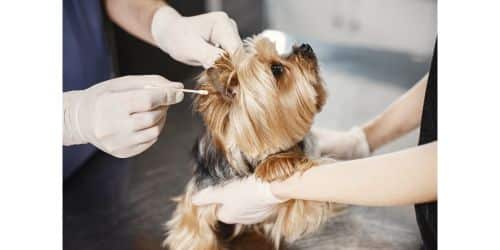Welcome to our in-depth look at brown discharge from a dog ear infection. As pet owners, we understand the stress and worry that arise when our furry pets encounter discomfort or strange symptoms. In this blog post, we will dig into the world of a dog ear infection, with a particular emphasis on the confusing topic of brown discharge. We want to provide you with helpful information to assist your beloved canine companion in finding relief and restoring their ear health, from understanding the causes to investigating viable treatment alternatives.
What is Brown Discharge Dog Ear Infection?
A brown discharge from a dog ear infection can be a frightening sight for pet owners. Brown discharge is frequently associated with otitis externa, an illness that affects the outer ear canal. Otitis externa is characterized by ear inflammation, discomfort, and debris collection. Blood, wax, or pus are just a few of the potential causes of the discharge’s brown color.
Understanding the Causes of Brown Discharge Dog Ear Infections
The ear of a dog is a delicate and sensitive part of the body, leaving it susceptible to infection. It is critical to understand the underlying causes of brown discharge dog ear infections to provide effective treatment and prevention. Let us explore the primary causes of these alarming illnesses.
#1. Bacterial Infections:
Bacterial infections are frequently the cause of brown discharge ear infections in a dog. Staphylococcus and Pseudomonas are the microorganisms most usually implicated. These bacteria enter the ear canal by a variety of routes, including swimming in contaminated water, excessive moisture collection, and ear scrapes and injuries.
Bacterial infections flourish in warm, wet conditions, so the ear canal of a dog is a great breeding site. Once in the ear canal, the bacteria multiply fast, causing irritation, itching, and the formation of brown discharge. It’s vital to understand that bacterial infections might develop as a result of other factors, such as allergies or anatomical anomalies.
#2. Yeast Infections:
Another common cause of brown-discharge dog ear infections is yeast overgrowth. Malassezia is the yeast most usually associated with these diseases. While yeast is a normal resident of a dog’s skin and ears, overgrowth can occur when specific triggers are present.
Yeast infections are frequently caused by underlying issues such as allergies (such as food allergies or environmental allergens), hormone abnormalities, or a weakened immune system. These conditions foster yeast development, resulting in irritation, inflammation, and the typical brown discharge.
#3. Ear Mites:
Ear mites, scientifically known as Otodectes cynotis, are parasites that live in the ear canals of dogs. These little insects can cause substantial discomfort and irritation to your pet. Ear mites are very contagious and quickly passed from animal to animal, making them a major cause of brown discharge ear infections, particularly in multi-pet households or communal settings.
Ear mites feed on ear tissue when they infiltrate the ear canal, causing inflammation, itching, and a brownish-waxy discharge. Dogs with ear mites frequently scratch and shake their heads, and they may develop secondary bacterial or yeast infections.
#4. Foreign Bodies:
Foreign objects can sometimes get into a dog’s ear canal, causing irritation and infection. Grass awns, plant material, and even small insects are examples of common foreign objects. These things can cause inflammation and create an environment that allows bacteria or yeast to flourish, resulting in brown discharge.
Foreign bodies not only cause discomfort but, if left untreated, can lead to more serious consequences. As a result, it’s critical to inspect your dog’s ears frequently, especially after outdoor activities, and to remove any visible debris or foreign items as soon as possible.
#5. Allergies:
Allergies, whether food or environmental, can play a role in reoccurring ear infections in dogs. Allergic reactions in the body cause inflammation and immunological responses, which can impact the ears.
Food allergies, for example, can cause chronic ear infections as a result of hypersensitivity reactions to specific substances. Pollen and dust mite allergies, for example, can create inflammation in the ear canal, making it more susceptible to infection and the generation of brown discharge.
Recognizing Brown Discharge Dog Ear Infection Symptoms
Being aware of your dog’s behavior and health is critical to their well-being. Recognizing the symptoms of brown discharge dog ear infections early on will help you seek timely veterinarian care and effectively handle the condition. Let’s look at some of the warning signs:
#1. Brown, Waxy Discharge:
The development of dark, waxy discharge in the ear canal is the most obvious indicator of a brown discharge dog ear infection in a dog. The viscosity of the discharge might range from thick and sticky to thin and watery. It may have a strong stench and be accompanied by other waste, such as pus or blood. Brown coloring is frequently associated with infection, inflammation, or the presence of blood.
#2. Odor:
An obnoxious and unpleasant odor coming from your dog’s ear can be an indication of an ear infection. The presence of bacteria or yeast, which produce specific substances during their metabolic activities, is usually responsible for the stench. The scent has been characterized as unpleasant, musty, and even yeasty.
#3. Scratching and Head Shaking:
Dogs with ear infections frequently show signs of pain, such as increased scratching and head shaking. Your dog may scratch the affected ear vigorously with their paw or rub their head against furniture or the floor. Inflammation and irritation caused by the infection are what cause the itchy feeling. Excessive scratching might cause more damage to the ear tissue and exacerbate the infection.
#4. Swelling and Redness:
A brown discharge ear infection in a dog is commonly characterized by inflamed and swollen ear tissue. Infected ears may be red, inflamed, and sensitive to touch. Internal and external swelling can cause the ear canal to seem narrower or partially closed. It’s crucial to know that scratching or rubbing may aggravate the redness and swelling.
#5. Discomfort
Ear infections in dogs can be uncomfortable, resulting in visible signs of discomfort. You may notice your dog’s head tilted to one side or held at an unusual angle. They may also show signs of irritation, aversion to being touched near the ear, or an overall shift in behavior. If your dog sobs or whines when you touch or examine their ears, this suggests severe pain and necessitates quick veterinary care.
#6. Loss of Balance and Coordination:
Dogs may develop balance and coordination deficits if the illness spreads or damages the inner ear in extreme situations. This is due to the ear’s relationship to the body’s balance system. If you find your dog tripping, falling, or having difficulty walking straight, this could signal an advanced stage of the infection that necessitates immediate veterinary attention.
#7. Constant Head Tilt:
A persistent head tilt, in which your dog continually tilts their head to one side, may indicate a more serious ear infection. When an infection affects the vestibular system, which is responsible for maintaining balance and orientation, a head tilt occurs. A prolonged head tilt should be handled seriously because it could suggest a deeper infection or inner ear damage.
Seeking Veterinary Assistance
If you suspect your dog has a brown discharge ear infection, check with a veterinarian immediately for an accurate diagnosis and treatment plan. A veterinarian will examine your dog’s ears thoroughly, including visual inspection, swabbing for microscopic investigation, and maybe prescribing other diagnostic testing.
Brown Discharge Dog Ear Infection Treatment Options
The underlying cause and severity of the infection will determine the method for treating brown discharge dog ear infections. Prompt veterinarian care is critical for selecting the best treatment option. Here are some examples of frequent treatment options:
#1. Veterinary Examination:
A thorough veterinary examination is the first step in treating a brown discharge ear infection. The veterinarian will examine the ear canal visually, determine the severity of the infection, and maybe collect samples for further testing. This examination aids in the identification of the underlying problem and guides therapy recommendations.
#2. Cleaning the Ear:
Cleaning the afflicted ear properly is critical for efficient treatment. To remove dirt, discharge, and any foreign objects, the veterinarian may perform ear flushing or utilize specialist ear cleaning treatments. To minimize further injury or suffering, it is critical to follow the veterinarian’s advice when cleaning the ear.
#3. Medications:
Medication is frequently administered to treat the illness as well as its underlying cause. The meds given will be determined by the diagnosis. Typical treatments include:
- Antibiotics: Antibiotics may be recommended in cases of bacterial infections or subsequent illnesses. These drugs aid in the removal of microorganisms and the reduction of inflammation in the ear canal.
- Antifungals: Antifungal drugs, such as antifungal ear drops or ointments, may be recommended if the infection is caused by yeast overgrowth. These drugs kill the yeast and restore ear balance.
- Parasiticides: If ear mites are the source of the infection, parasiticides in the form of ear drops or topical therapies can be used to eradicate the mites. To avoid re-infestation, treat all pets in the home at the same time.
- Anti-inflammatory Drugs: The veterinarian may give anti-inflammatory medications, such as corticosteroids, to treat pain, swelling, and discomfort. These drugs provide relief by reducing inflammation in the ear canal.
- Allergy Management: If allergies are a factor in recurring ear infections, the veterinarian may suggest allergy management measures. Dietary adjustments, hypoallergenic diets, allergy testing, and immunotherapy may be included.
#4. Follow-up Care:
Regular follow-up appointments are essential for monitoring therapy progress and making any required modifications. Based on your dog’s response, the veterinarian may do additional ear cleanings, reevaluate the infection, or adjust the treatment plan.
#5. Preventive Measures:
It is critical to avoid future ear infections. The veterinarian can advise you on proper ear cleaning procedures, frequency, and materials to use. Furthermore, addressing underlying reasons such as allergies or structural anomalies might help reduce the likelihood of recurring infections.
Home Care Tips
Alongside veterinary treatment, you can provide additional care at home to support your dog’s recovery:
- Follow Medication Instructions: Administer prescribed medications as directed by your veterinarian, ensuring the full course of treatment is completed.
- Avoid Irritants: Keep your dog away from potential irritants, such as dusty environments, excessive ear scratching, or exposure to water, while the infection is being treated.
- Monitor Progress: Regularly observe your dog’s ears for any changes or worsening of symptoms. If you notice any concerns, promptly consult your veterinarian for further guidance.
When to Consult Your Veterinarian Again
While home care and therapy can be beneficial in many cases of brown discharge dog ear infections, there are times when a trip to the vet is required. Consider seeking additional veterinarian assistance if:
- Symptoms Persist or Worsen: If your dog’s symptoms persist or worsen despite therapy, it may suggest that a different strategy or a more thorough evaluation is required.
- Recurrent Infections: If your dog has recurring ear infections, there could be underlying causes, such as allergies or structural difficulties, that need to be addressed. Your veterinarian can assist you in identifying and treating these underlying problems.
- Severe Symptoms: If your dog is experiencing significant pain, swelling, or other troubling symptoms, you must seek quick veterinary assistance.
What are the risks of untreated brown discharge ear infection?
Untreated brown discharge ear infections in dogs can pose several risks and complications. It’s crucial to address these infections promptly to prevent potential health issues. Here are some risks associated with leaving a brown discharge ear infection untreated:
- Spread of Infection
- Chronic or Recurrent Infections
- Pain and Discomfort
- Damage to the Ear Structures
- Secondary Infections
- Aural Hematoma
- Systemic Infection
How do you treat brown discharge in dog ears?
Depending on the underlying reason, the best treatment for your dog’s yeast ear infection may include:
- Regularly clean your pup’s ears at home with a medicated cleanser.
- Topical medications.
- Oral antibiotics.
- Anti-inflammatory medications.
Is brown stuff in dogs’ ears normal?
Our dogs have ear wax in their ears like you and me that is meant to capture unwanted particles and dirt. A thin layer of yellow ear wax lining the inside of their ears is quite typical, as is a small quantity of light brown wax.
Do dog ear infections bleed?
Discharge from the ear (sometimes thick and pus-like or crimson), sudden hearing loss, a red and inflamed ear canal, pain when touching the ear, a head tilt, stumbling, and nystagmus (back-and-forth darting of the eyes) are all signs that your dog may have a ruptured eardrum or middle ear infection.
Conclusion
Brown discharge dog ear infections are a common source of anxiety among pet owners, but with the appropriate information and preventative actions, you can help your dog find relief and avoid repeat occurrences. Remember to seek veterinary care for an accurate diagnosis and treatment, to follow your veterinarian’s recommendations, and to practice excellent ear hygiene. You can ensure your canine companion’s ear health and overall well-being by being attentive and proactive.
Related Articles
- What is the Best Flea Treatment for Puppies Under 12 Weeks?
- Best Ear Mite Treatment For Cats In 2023
- HOW TO PREVENT AND KEEP TICK OFF DOGS: Best Treatments and Remedies
- Soft Tissue Sarcoma In Dogs: Symptoms and Treatment
- Prostate Cancer in Dogs: Symptoms, Diagnosis, and Treatment Options
- Is It Safe for Dogs to Drink Soda?
- How Long Can Cats Go Without Food And Water?






